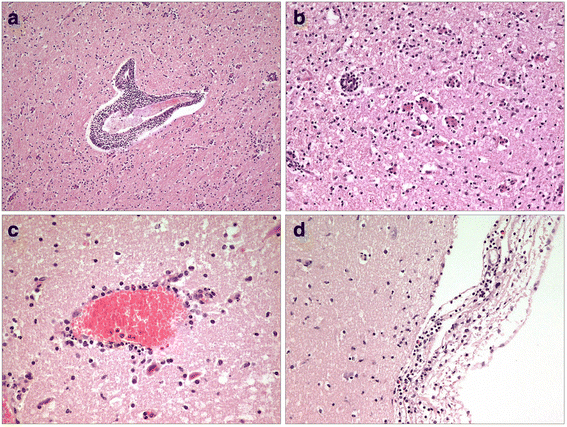Tick-borne encephalitis in a naturally infected sheep
- PMID: 28830430
- PMCID: PMC5567888
- DOI: 10.1186/s12917-017-1192-3
Tick-borne encephalitis in a naturally infected sheep
Abstract
Background: Tick-borne encephalitis (TBE) is the most important viral tick borne zoonosis in Europe. In Germany, about 250 human cases are registered annually, with the highest incidence reported in the last years coming from the federal states Bavaria and Baden-Wuerttemberg. In veterinary medicine, only sporadic cases in wild and domestic animals have been reported; however, a high number of wild and domestic animals have tested positive for the tick-borne encephalitis virus (TBEV) antibody.
Case presentation: In May 2015, a five-month-old lamb from a farm with 15 Merino Land sheep and offspring in Nersingen/Bavaria, a TBEV risk area, showed impaired general health with pyrexia and acute neurological signs. The sheep suffered from ataxia, torticollis, tremor, nystagmus, salivation and finally somnolence with inappetence and recumbency. After euthanasia, pathological, histopathological, immunohistochemical, bacteriological, parasitological and virological analyses were performed. Additionally, blood samples from the remaining, healthy sheep in the herd were taken for detection of TBEV antibody titres. At necropsy and accompanying parasitology, the sheep showed a moderate to severe infection with Trichostrongylids, Moniezia and Eimeria species. Histopathology revealed mild to moderate necrotising, lymphohistiocytic and granulocytic meningoencephalitis with gliosis and neuronophagia. Immunohistochemistry for TBEV was negative. RNA of a TBEV strain, closely related to the Kumlinge A52 strain, was detected in the brain by quantitative reverse transcriptase polymerase chain reaction (RT-qPCR) and subsequent PCR product sequencing. A phylogenetic analysis revealed a close relationship to the TBEV of central Europe. TBEV was cultured from brain tissue. Serologically, one of blood samples from the other sheep in the herd was positive for TBEV in an enzyme-linked immunosorbent assay (ELISA) and in a serum neutralisation test (SNT), and one was borderline in an ELISA.
Conclusion: To the authors' knowledge this is the first report of a natural TBEV infection in a sheep in Europe with clinical manifestation, which describes the clinical presentation and the histopathology of TBEV infection.
Keywords: ELISA; Histopathology; Ixodes ricinus; RT-qPCR; TBEV; Tick-borne encephalitis virus.
Conflict of interest statement
Ethics approval and consent to participate
Not applicable.
Consent for publication
Not applicable.
Competing interests
The authors confirm that no competing financial interests exist.
Publisher’s Note
Springer Nature remains neutral with regard to jurisdictional claims in published maps and institutional affiliations.
Figures


References
-
- Robert Koch-Institute FSME: Risikogebiete in Deutschland. Epid Bull. 2007;15:129–135.
-
- Robert Koch-Institute FSME: Risikogebiete in Deutschland. Epid Bull. 2016;2:151–162.
Publication types
MeSH terms
Substances
LinkOut - more resources
Full Text Sources
Other Literature Sources

